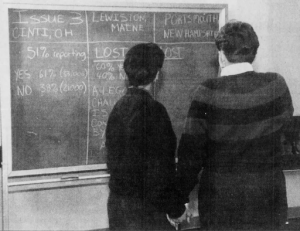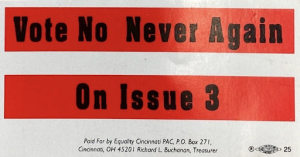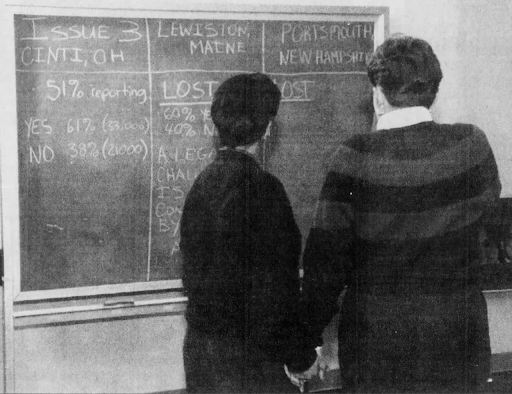
In the 1990s, LGBTQ students at UC faced many problems. The AIDs crisis, then a growing issue in the US, affected many Cincinnatians and University of Cincinnati students. But Cincinnati was a conservative city, and LGBTQ students remarked that the campus was far less accepting than they had hoped.

Queer students expected violence from other students. Two girls in particular, students named Karla and Anne, recounted their experiences to Clifton Magazine in 1991: “We haven’t been physically attacked yet, but we have experienced some harassment.” Anne stated that at a war protest, counter-protesters chanted that the majority gay crowd should be bombed to “cure AIDs” and that all the “f*ggots” on campus should go home.
Other incidents, also reported in Clifton Magazine, occurred often throughout the ’90s at UC. Some students put up posters with an image of two monkeys “copulating” surrounded by anti-gay slurs. Anti-gay telephone calls were made each year to the UC Alliance of Lesbian, Gay, and Bisexual People, including one caller that said, “kill all gays and lesbians.” Worried about violence, LGBTQ students dropped out of student groups and isolated themselves. Some students even skipped class for “weeks” out of fear that their classmates would hurt them if their sexuality was discovered.
LGBTQ groups on campus existed, but many students feared attending because meetings sometimes drew violence. A researcher with the FBI, Jack McDevitt, stated that, “… kids out for a thrill will go looking for blacks. If [they find] none, then they will go for gays. And they know where to find them. They go to bars or gay associations. These attacks … are incredibly violent.” LGBTQ students also faced high risks of suicide on campus, but students stated that campus officials refused to acknowledge the issue.


Not only were LGBTQ people in Cincinnati facing violence, but little was being done to help. In the early 1990s, Cincinnati suggested a resolution, Issue 3, that would prohibit the enactment of any law that specifically protected the rights of lesbians and gay men. In summary, the law said LGBTQ people didn’t count as a protected group.
Two sides debated and protested this issue. The pro-Issue 3 group consisted of groups including many Christian organizations. Mark McNiel, an advocate of Issue 3, held the common belief that homosexuality was an illness and a sin, not something that deserved to be protected by the law. While Christian people made up the majority of anti-gay advocates, some Cincinnati religious figures condemned those that held prejudice toward LGBTQ people. One minister, Peter J. Gomes, argued strict interpretations of the bible and religious fundamentalism caused people to wrongfully hate gays and lesbians. “To maintain itself, fundamentalism must always label the other and a deviant.”
The other side of the debate consisted of LGBTQ people and allies, both on campus and throughout Cincinnati, that believed in protections for LGBTQ people. Anti-Issue 3 advocates stated the high rates of violence, suicide, and poverty among LGBTQ populations when justifying protections.
In 1993, Issue 3 passed with 62% support for Cincinnati voters. The law is still in place today. While LGBTQ activists could not stop the passage of Issue 3, the University passed its own nondiscrimination waver that “reaffirms the policy that discrimination based on … sexual orientation … will not be practiced.”
The ‘90s marked a difficult time for LGBTQ people in Cincinnati. Students expected harassment and violence and isolated themselves. As a result, isolation contributed to the high rates of suicide among LGBTQ students. The introduction of Issue 3 was a blow to many LGBTQ activists in Cincinnati, who faced constant discrimination but were unable to gain protection.
Thanks to activists that faced the violence and hatred from the community in order to change things, students on campus today can expect to be protected from violent acts based on their identity. New initiatives by the University like the LGBTQ faculty and staff association, the LGBT center, the office of Equity and Inclusion, and a relatively new way for students to affect inclusion on campus, the Student Diversity and Inclusion Council. Cincinnati has come a long way since the violence and oppression of the 90s, and LGBTQ students continue to push for more representation and support on campus.

